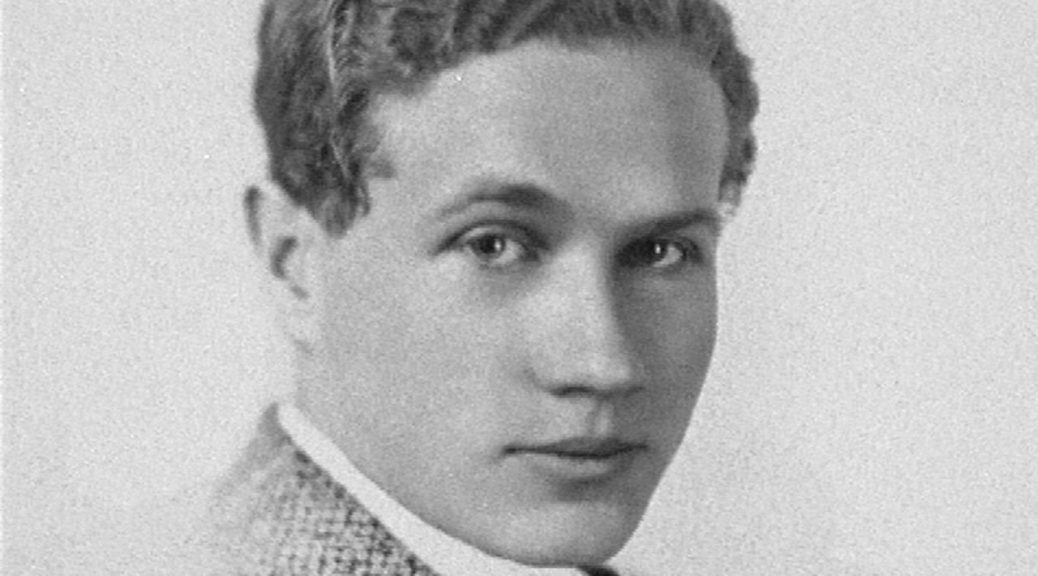COUNT EIGIL KNUTH died on this date (b: 1903). Count Knuth was a Danish explorer, archaeologist, sculptor and writer. He is referred to as the “Nestor (“elder statesman”) of Danish polar explorers.” His archaeological investigations were made in Peary Land and adjacent areas of High Arctic Greenland. Knuth was made a Knight of Dannebrog
He was born in Klampenborg, Denmark (near Copenhagen). His parents were Count Eigil Knuth Sr, a captain, and Djimphna (née Gamel). His hero was the Norwegian explorer Fridtjof Nansen who, in 1888, was the first to cross the Greenland Icecap; the trip was financed by State Councillor Augustinus Gamel, a Danish businessman, and Knuth’s maternal grandfather.
Gamel’s birth gift to his grandson was a present Gamel had received from Nansen: the compass Nansen carried on his Greenland icecap expedition. Knuth studied building technology at the Royal Danish Academy of Fine Arts and then woodcarving at Val Gardena in Italy between 1926 and 1928. He published his first book, on the subject of philosophy, in 1927, revealing an affinity with the Danish philosopher Soren Kierkegaard. In 1932, Knuth graduated as a gymnastics teacher from Ollerup Physical Training College in Denmark.
Knuth’s first trip to Greenland occurred in 1932 on an archaeological dig to excavate old Norse sites on West Greenland’s coast. Knuth spent the next two years as an art critic for the Copenhagen newspaper Dagens Nyheder. Assisting Dr. Roussell and Dr. Poul Nørlund during the summer of 1934, Knuth excavated old Norse ruins at Igaliko. In 1935, Dr. Helge Larsen, Ebbe Munck, and Knuth, as archaeologist, assisted on the Augustine Courtald Expedition to East Greenland, during which Gunbjrns Fjeld, Greenland’s highest mountain, was climbed.
The following summer, in 1936, Knuth, Robert Gessain, and Michel Perez participated in the French Trans-Greenland Expedition under Paul-Emile Victor, crossing the Greenland ice cap, starting at Christianshab in the west, and ending at, an Inuit settlement in the east. It was here that Knuth worked as a sculptor, producing a notable series of busts of the local Inuit. Knuth financed the bulk of his next expedition, known as Dansk Nordgrønlandsekspedition 1938—39, udsendt af Alf Trolle, Ebbe Munck og Eigil Knuth til Minde on Danmark-Ekspeditionen (“Danish Northeast Greenland Expedition 1938—39, sent out by Alf Trolle, Ebbe Munck, and Eigil Knuth in memory of the Denmark Expedition”), arriving in Greenland with his co-leader and friend, Ebbe Munck, on June 19, 1938. The crew consisted of six more men. It was the first Danish Greenland expedition to make use of an airplane, a de Havilland Tiger Moth.
With the start of war, Knuth could not return to Greenland as planned, instead, becoming an announcer for Denmark Radio in the Danish resistance movement. During the period of 1948 — 50, Knuth was back in Greenland and made several discoveries, including a large tool collection of the Thule culture and tool fragments of the Dorset culture.
His most important contribution, however, was the first identification and demonstration of Independence culture and Independence II culture immigration waves of Paleo-Eskimo, spread apart by almost 3000 years. He named the cultures “Independence” after the Independence Fjiord located in Peary Land. In addition to sculpting, he produced paintings and watercolors. Some of his works were on display at the 1939 New York World’s Fair.
